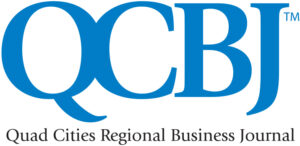The Quad Cities economy saw slow progress in the first quarter of 2022, and the region’s Return to Normal Index showed signs of strength returning to the regional economy.

That’s according to the Quad Cities Chamber of Commerce’s Q1 economic report prepared by University of Illinois Professor Kenneth A. Kriz for the six-county region spanning Rock Island, Henry and Mercer counties in Illinois, and Scott, Clinton and Muscatine counties in Iowa. The report, however, also saw challenges looming for both the regional and national economies.
The Quarter 1 QC Return to Normal Index showed that after moving sideways during the fall and early winter of 2021, the regional economy picked up pace in the period that ran from Jan. 1 to March 31, 2022.
At the same time, several factors combined during the first quarter to draw down economic growth. Among the things shrinking the economy were businesses spending down inventory, a decline in exports and a growth in imports. In the previous quarter, Mr. Kriz wrote, the economy was up and down due to the continuation of the strong economic recovery that began in the second half of 2020, and then a slow down due to retrenchment prompted by the Omicron COVID-19 variant.
Going forward, the report indicates a number of uncertainties regarding the path of economic expansion including concerns over both short-term inflation and long-term persistent inflation
Nationwide economic growth, measured by the Real Gross Domestic Product (GDP) was minus 1.4% in the first quarter. And, Mr. Kriz said, the combined pressures of rising inflation, rising interests and “concerns over fiscal drag coming from the inability of the Biden administration to pass large legislative packages caused a significant drag on the economy.” That drag overwhelmed the impact of reopening that came after the Omicron variant proved far less virulent than originally feared.
Both nationally and regionally, the labor market continued its slow recovery in the first three months of 2022. But first quarter employment growth slowed more dramatically in the Quad Cities region than nationwide, according to the regional report. National payroll increased by 1.1% in the first quarter, down modestly from 1.3% growth in 4Q 2021. In the QC region, the rate of employment growth fell from 1.5% in 4Q 2021 to 0.4% in the first quarter.
“Unemployment rates demonstrate a growing divergence between national and regional labor market conditions,” the report said. “Rates improved both nationally and regionally in the past two quarters, but rates have fallen more quickly at the national level. National unemployment rates are now below where they were in March 2020, whereas the QC region remains slightly above.”
In addition, according to the report, there are many uncertainties regarding the path of continued economic expansion. For example, both short-term inflation and long-term persistent inflation remain a concern.
The chamber’s market report also detailed a number of economic drivers and drawbacks for the Quad Cities economy.
Among the economic drivers are:
- Automation, “the new cadence the chamber is sharing with Illinois and Iowa manufacturers is on the rise.”
- Businesses are focusing more on retaining and upskilling workers.
- Construction remains strong in the region and new housing and senior development communities are rising.
- Contractors are busy with renovations and handyman businesses are expanding.
- Steel is easier to find.
- Foot traffic is increasing as consumers return to retail stores.
- Restaurants are serving more customers after the COVID-19 reopening.
- The Quad Cities International Airport has recovered 80% of its passenger numbers from pre-pandemic levels.
- A major runway reconfiguration project has been launched at QCIA.
Drawbacks impacting the region include:
- Manufacturers continue to find sourcing raw materials and components is a challenge.
- Challenges remain a factor in meeting production and profitability metrics.
- QC employers in the logistic industry are challenged with labor shortages (specifically truck drivers), a lack of shipping containers, high transportation costs and supply chain disruptions.
- Labor uncertainty is interfering with long-term production planning and impacting bottom lines.
- Inflation is presenting a larger challenge than supply. Companies can’t keep up with the constant change in prices for materials and do not have a historical context to predict how high and how long prices will increase.
- As employers move teams back to the workplace, they are challenged by identifying the right office size and layout to drive the most collaboration, productivity and positive culture.
- The pilot shortage continues to strain the airline industry. Early-buyout options accelerated a shortage that was already looming.
- Large airlines are poaching from regional air carriers to fill vacancies. The pilot shortage and other staffing challenges are a major roadblock to full travel recovery.




